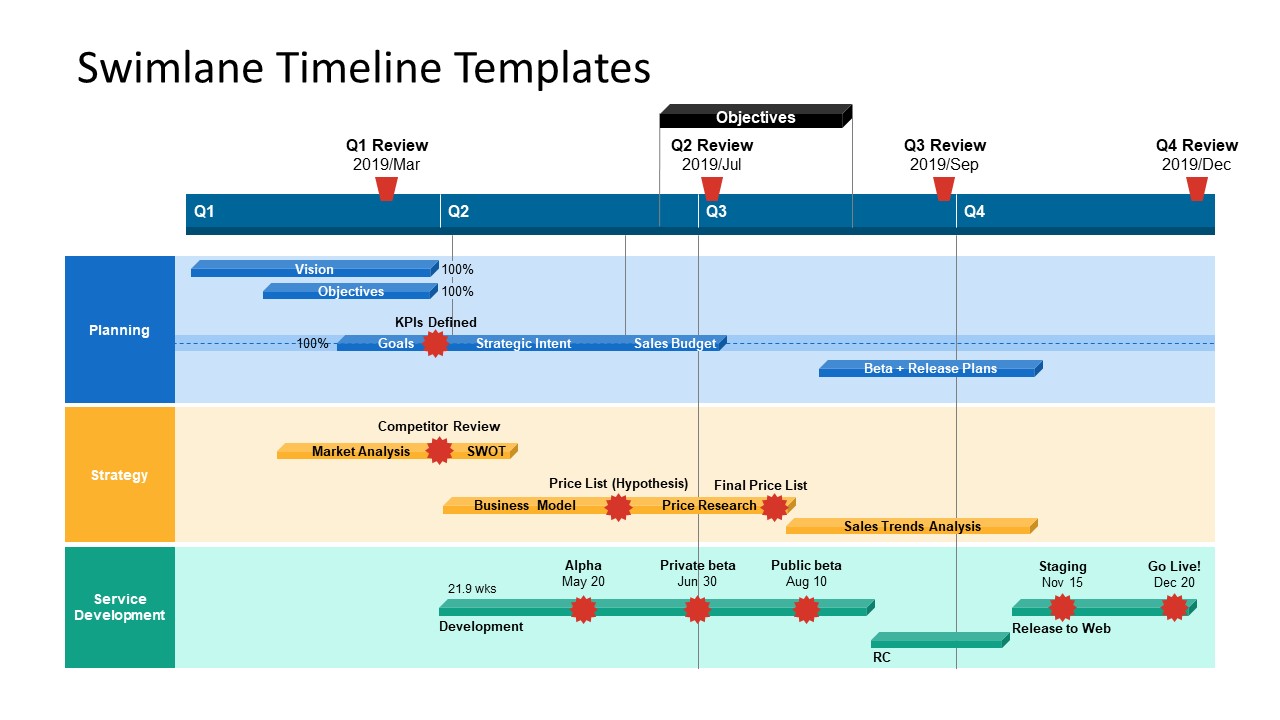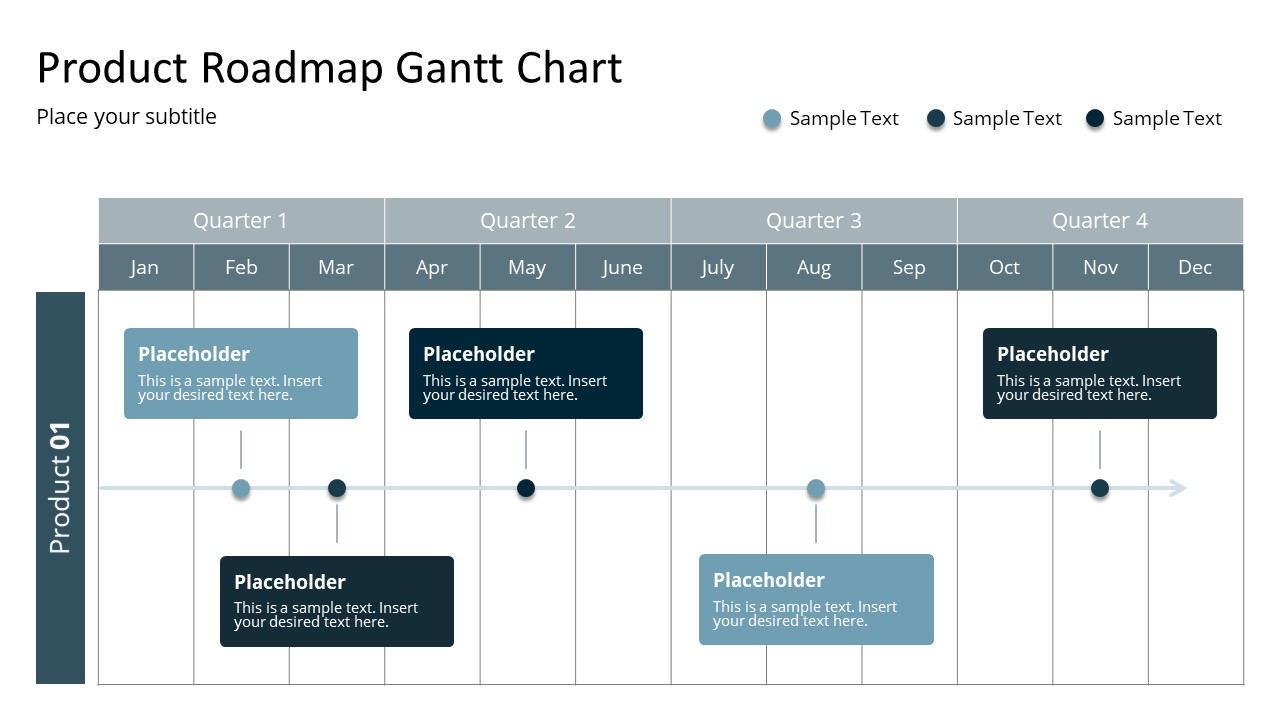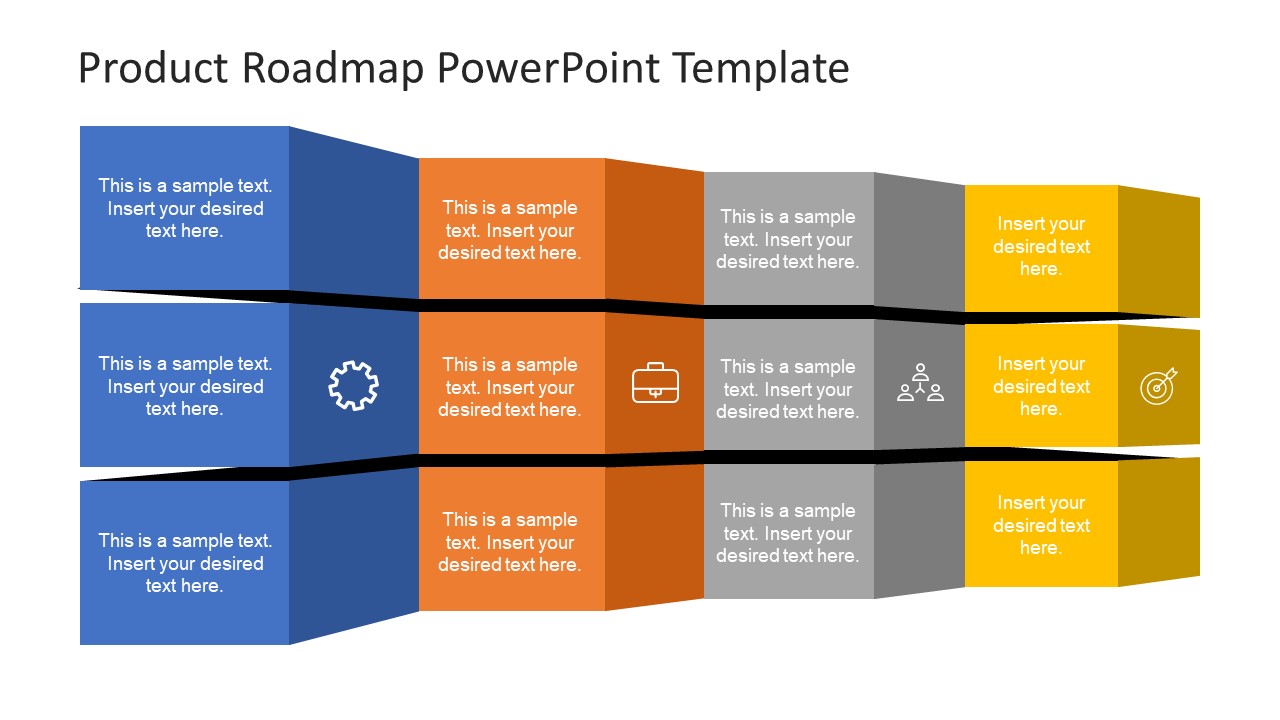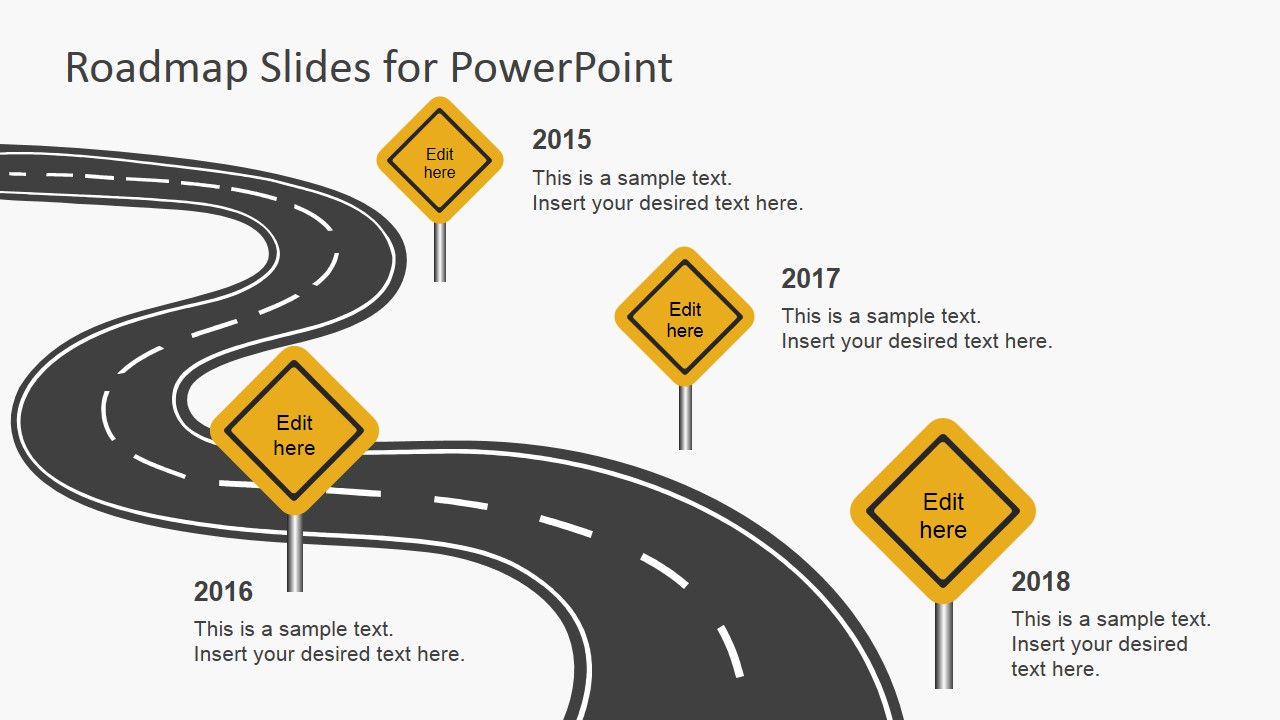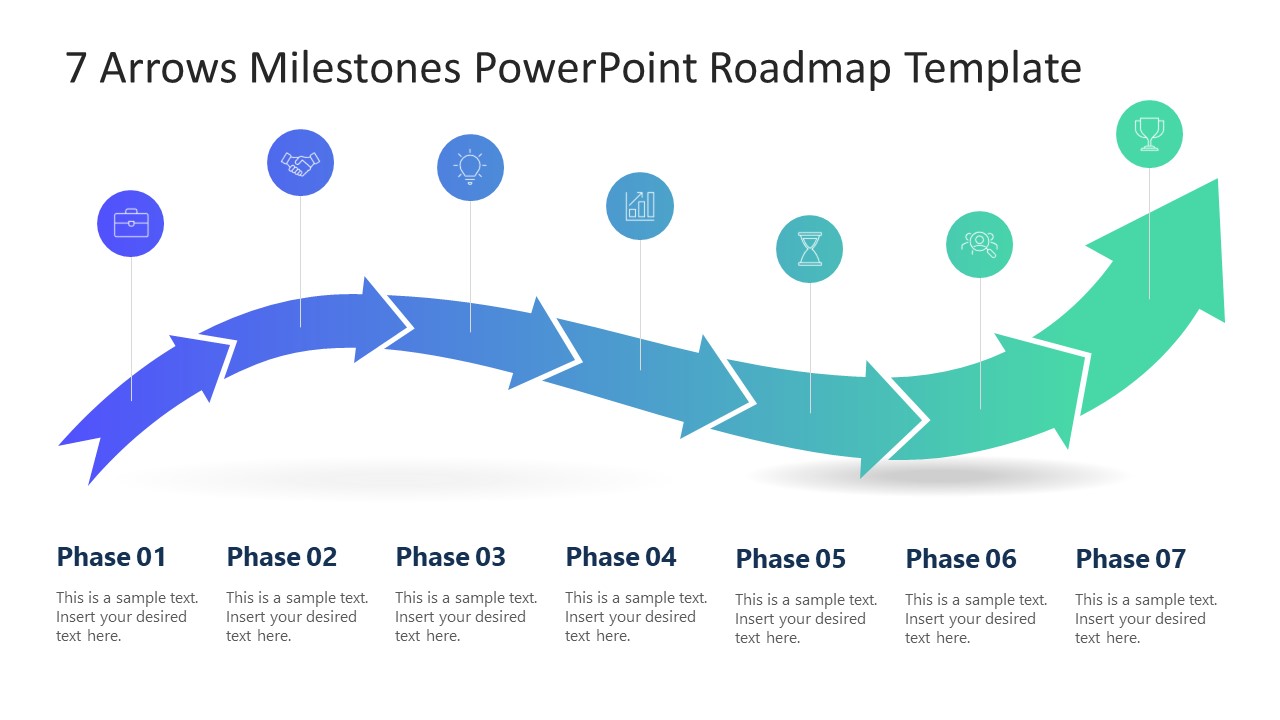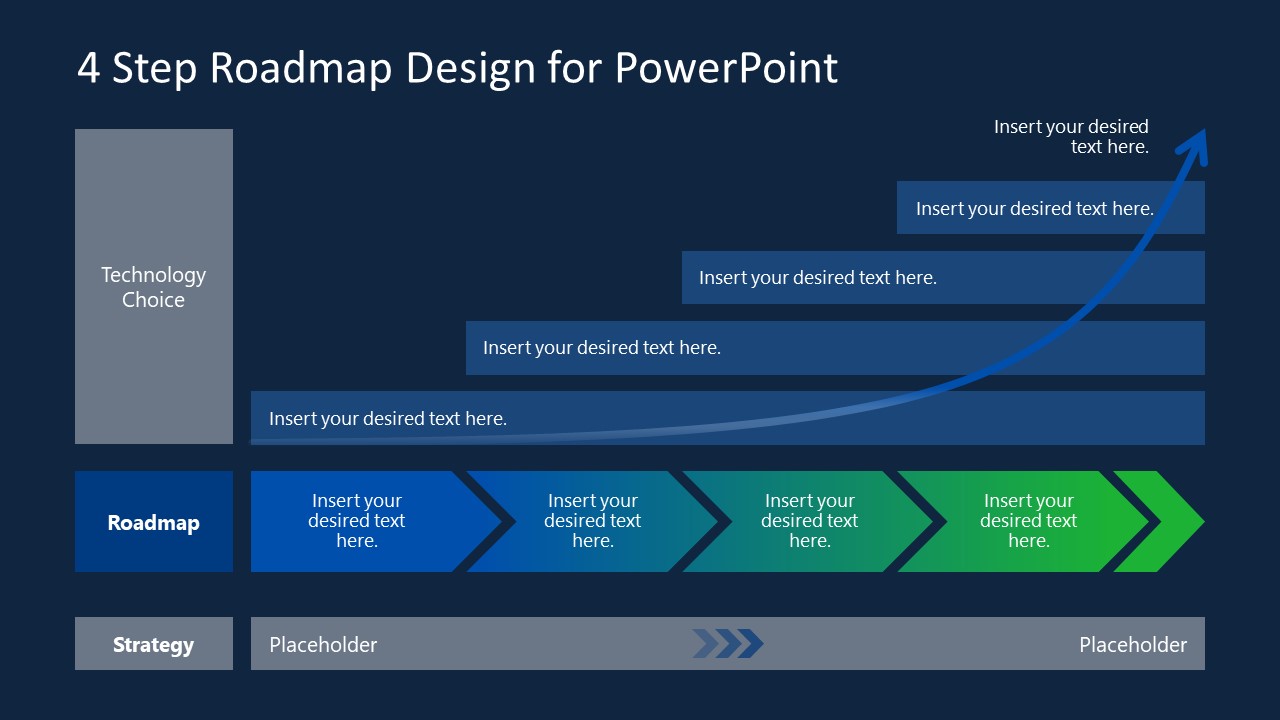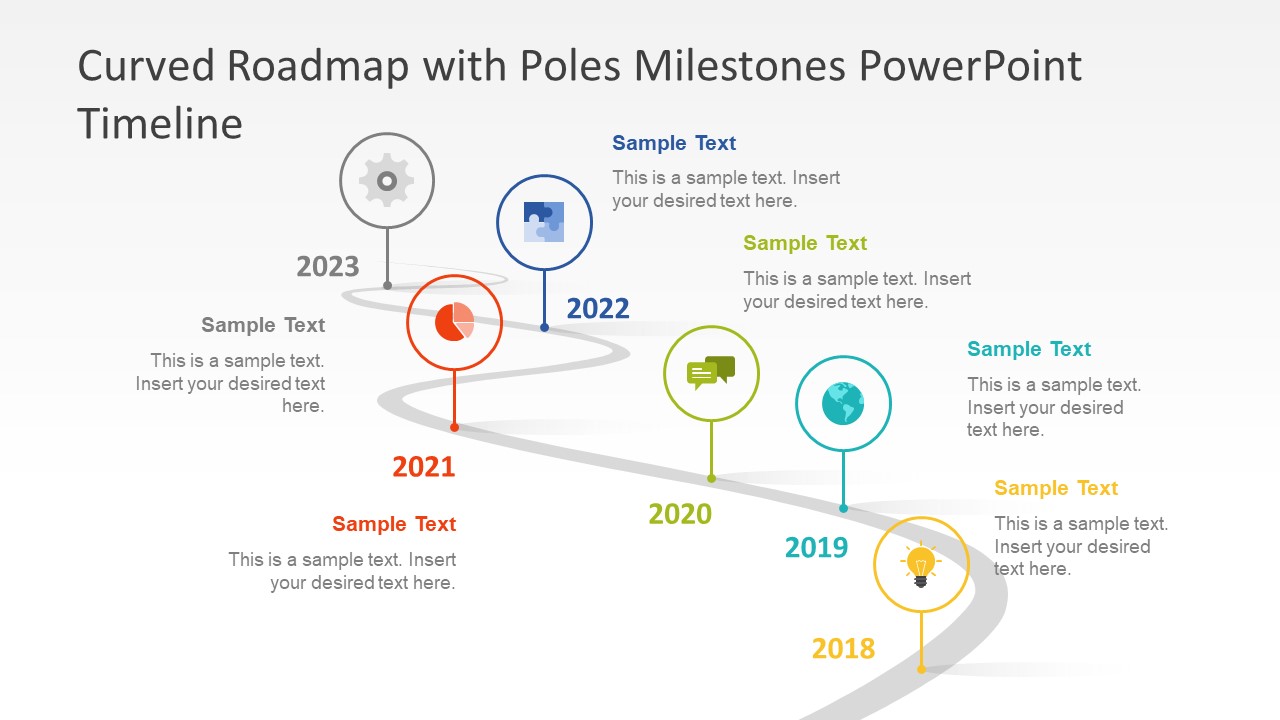
Product Roadmaps are an essential tool for any organization looking to clarify its product development process. Much is being said about how they can help teams visualize and keep an effective product development agenda over a specific period, but what does it truly bring to business professionals rather than a working standard in many industries?
In this article, we will cover in detail what a Product Roadmap is. Its story and application in Agile environments, such as the SCRUM methodology. We’ll navigate each step of the road, from ideation to how to successfully present a Product Roadmap. As an extra, stay tuned for common pitfalls in Product Roadmap creation and how to prevent them, as well as our recommendation for Product Roadmap PowerPoint templates. Let’s get started.
Table of Contents
- What is a Product Roadmap
- What is a Roadmap in Agile
- Who uses Product Roadmaps
- Why should you create a Product Roadmap
- Types of Product Roadmaps
- How to build a Product Roadmap
- Which content to include in a Product Roadmap
- 4-Step process to build a Product Roadmap
- How to plan technical debt in a Product Roadmap
- How to prioritize items in a Product Roadmap
- How to define metrics of success in a Product Roadmap
- How to add multiple products to a single Product Roadmap file
- Design suggestions for Product Roadmaps
- Tools to build a Product Roadmap
- How to present a Product Roadmap
- Updating a Product Roadmap
- Reasons why your Product Roadmaps may fail
- Best PowerPoint Templates for Product Roadmaps
- Closing Thoughts
What is a Product Roadmap
Whenever we mention a Product Roadmap, we refer to a high-level action plan of how a product or service will develop, laying out the goals to achieve over a time period. It is a versatile tool that can be adapted to showcase the evolution of a product/service to be released, as well as to upgrade an existing product or service with new functionalities.
We can say a product roadmap is a shared document between different stakeholders that outlines a product’s vision, priorities, future outlook, and evolution over time. It serves the role of aligning the organization toward a fixed set of short and long-term goals that are strictly relevant to the product’s performance, whilst at the same time defining how these goals shall be achieved and by whom. Much like other types of roadmaps, a product roadmap is the execution plan of a product strategy.
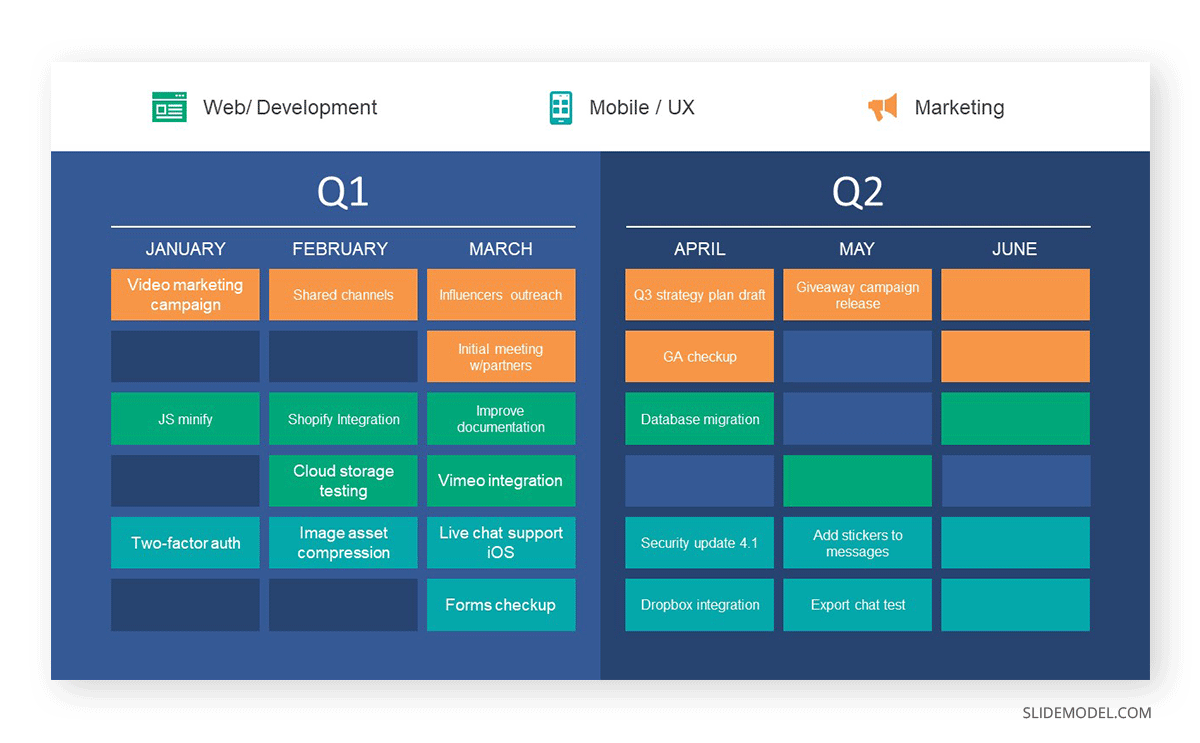
What is a Roadmap in Agile
If you browse product roadmaps, their definition, or tools to create one, you are likely to come across mentions of roadmaps in Agile. For what refers to Agile practices, an Agile roadmap is a critical tool to understand the context in which daily work unfolds, as it is the guidance by which all efforts should be focused – hence the importance of sharing an agile roadmap with the entire group of people involved in the product development.
However, we must clarify that any product roadmap is not where to-do(s) tasks from individual projects are laid out. The product roadmap is a reference document where vision and strategy align; therefore, tasks required to complete an evolution stage in the roadmap have to be previously defined, with a timeframe for completion, and dependencies established (i.e., which tasks have to be completed in order for the upcoming ones to start).
Who owns the Product Roadmap in SCRUM
SCRUM frameworks are the common application of product management roadmapping tools, and it is a common question to ask who owns these product roadmaps. The Product Manager is the owner of any product roadmap and the solely responsible for involving stakeholders and keeping them accountable to fulfill the tasks in time.
Sometimes, Product Owners overlap in their role functions, transitioning into product managers, which is why people tend to confuse who is the actual owner of a product roadmap.
To be on the safe side, we would like to make this clarification.
A Product Owner is a person that builds the vision for a product, meaning they handle the business side of the project.
The Project Manager is the person that handles the technical decisions of the product development.
If the Product Owner and the Product Manager roles aren’t fulfilled by the same person, we highly encourage involving the Product Owner at each stage of the product development.
Who is responsible for managing the Product Roadmap
The product manager is the person in charge of the entire product lifecycle. Among the responsibilities of the product manager, we can find:
- Work as the strategic leader for the technical aspects of the product development.
- Gather ideas, relevant data, and strategic insights for any planning session.
- Coordinate the roadmap planning meetings.
- Communicate the strategic vision for the product clearly, so all team players are aligned with it.
- Organize and moderate the scoring discussion (meeting in which the team agrees on feature ideas for the product development).
Who uses Product Roadmaps
At a corporate level, executives, customers, teams, and other relevant stakeholders are the audience of any product roadmap. Depending on whom shall see the document, is where you need to tailor the “vision” of this document to their interests. Let’s put some examples.
The Production Team of your organization will focus on the technical aspects of the product implementation and the deadlines to meet. The value of this document is linked to communicating, as detailed as possible, the information relevant to product features, their stage of development, or any upcoming change that may alter future tasks in the original plan.
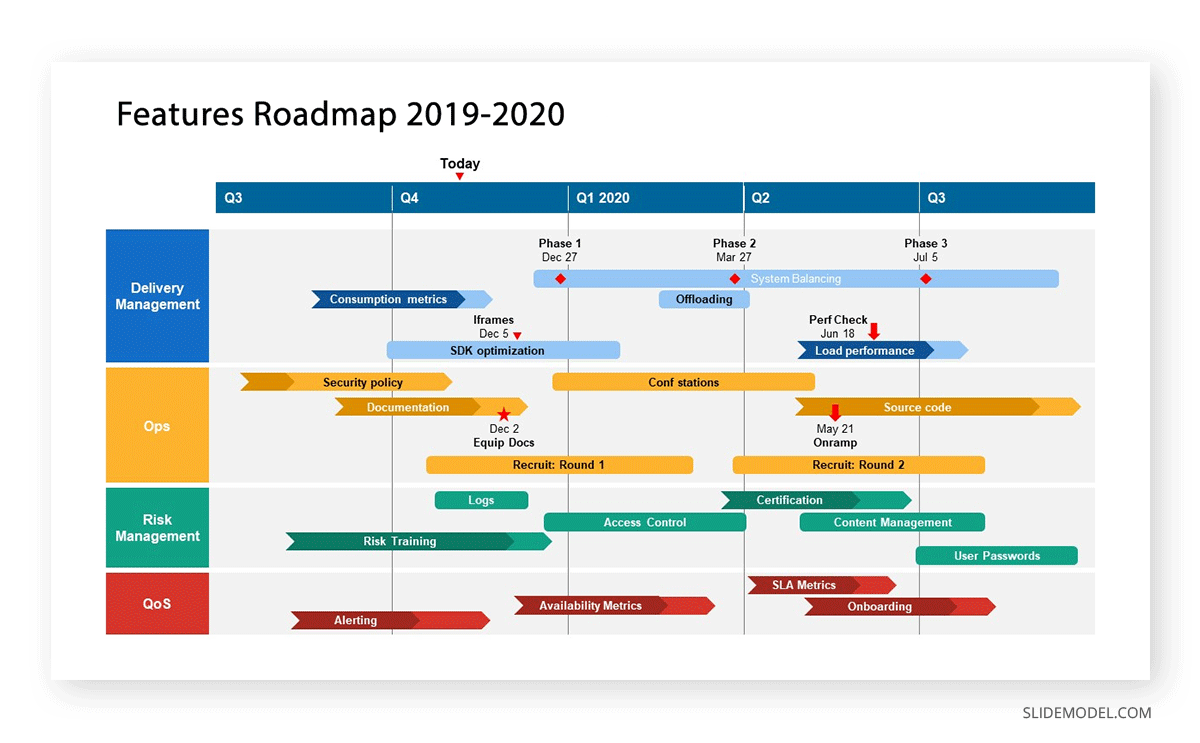
In contrast, an Executive Team will focus on the strategic part of the product roadmap, how the vision for this product is aligned across all stages, which are the expected market numbers, deadlines, etc. And that’s just a side-by-side comparison of two Internal Roadmaps – we will expose the different types of product roadmaps later on in this guide.
Why should you create a Product Roadmap
As we mentioned earlier, product roadmaps are tools for strategic vision alignment. They bring clarity about a project’s outcome and help stakeholders to stay in touch with different areas and the impact of their work.
Depending on the hierarchy level, the influence of product roadmaps may vary in daily work. For the leadership, this tool provides updates on pending and completed work, like a snapshot of what’s happening and what’s bound to happen. It reduces the unrequired technical jargon so leadership can focus on what boosts the team’s performance.
On the side of a product owner or a product manager, counting with a product road map, this tool helps unify teams, improving internal communication and putting the focus into effective task completion.
For the team, learning how to define a product roadmap is the first step toward identifying dependencies in your product and sorting out which tasks should take priority. Teams should document the backlog of each sprint, which, in turn, helps to address where a revision of the original strategy happened, why it was triggered, and which was the outcome of such a resolution.
Alternatively, check our tutorial about how to create a roadmap in PowerPoint.
Types of Product Roadmaps
Internal Product Roadmaps
Internal roadmaps guide the efforts of any organization, and they can be tailored depending on the team reviewing the product development work. We can find internal roadmaps for sales, internal roadmaps for executives, and internal roadmaps for developers.
Internal roadmaps for executives highlight how to boost customer satisfaction, reach new markets, and drive growth through the new product. The vision is focused on terms of the company’s growth, and it must reflect the metrics that prove a good criterion.
Internal roadmaps for sales have a bit of a hybrid purpose since they can also be used as external roadmaps. This implies that it’s not uncommon for sales representatives to show insights into the sales product roadmap with customers to boost the chances of closing a deal. In such cases, the internal roadmaps have to trim the expected launch dates in the sales presentation to avoid any potential compromise that cannot be fulfilled in time.
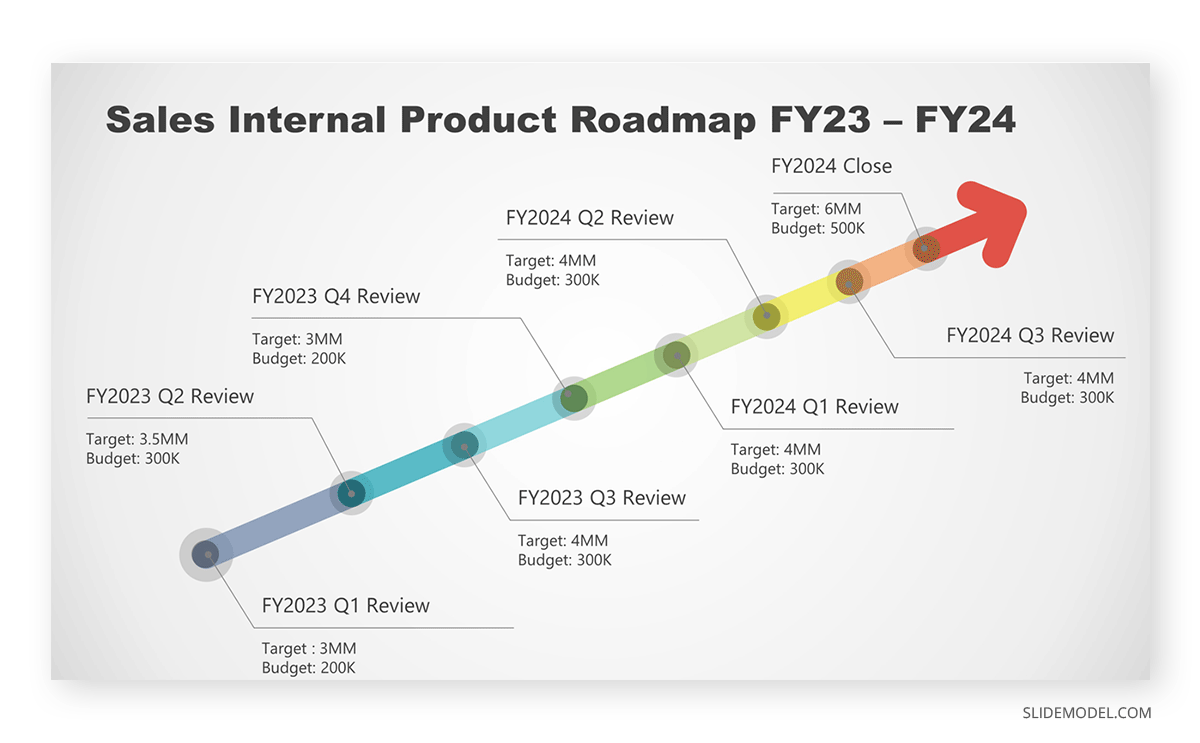
External Product Roadmaps
External roadmaps are documents shared with customers and prospects. Its relevance is to showcase the product’s benefits in their lives, hence why it is critical for these documents to be visually appealing and easy to understand.
Any internal process is trimmed out of the external roadmap and has to offer realistic expectations. Do not list features you already know your team won’t be able to fulfill for the release stage.
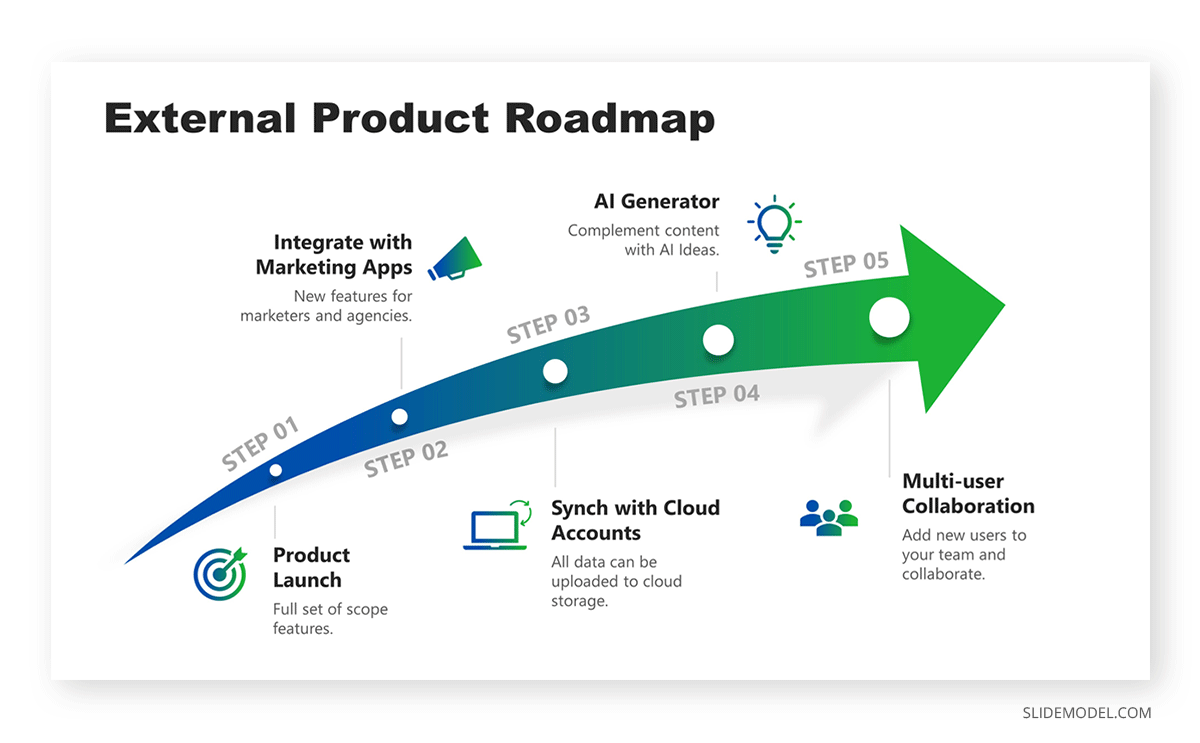
Epic Roadmap
Epic roadmaps are mostly used in Jira software, and their purpose is to help Agile and DevOps methodologies to organize their work. We must understand three core concepts to comprehend the purpose of an Epic roadmap.
- Epics are cumulative workloads that can be broken down into smaller, simpler tasks.
- Stories are the sub-tasks that build one epic. If you break down an epic, you get a number of stories.
Initiatives can be defined as a collection of epics aligned toward the same vision.
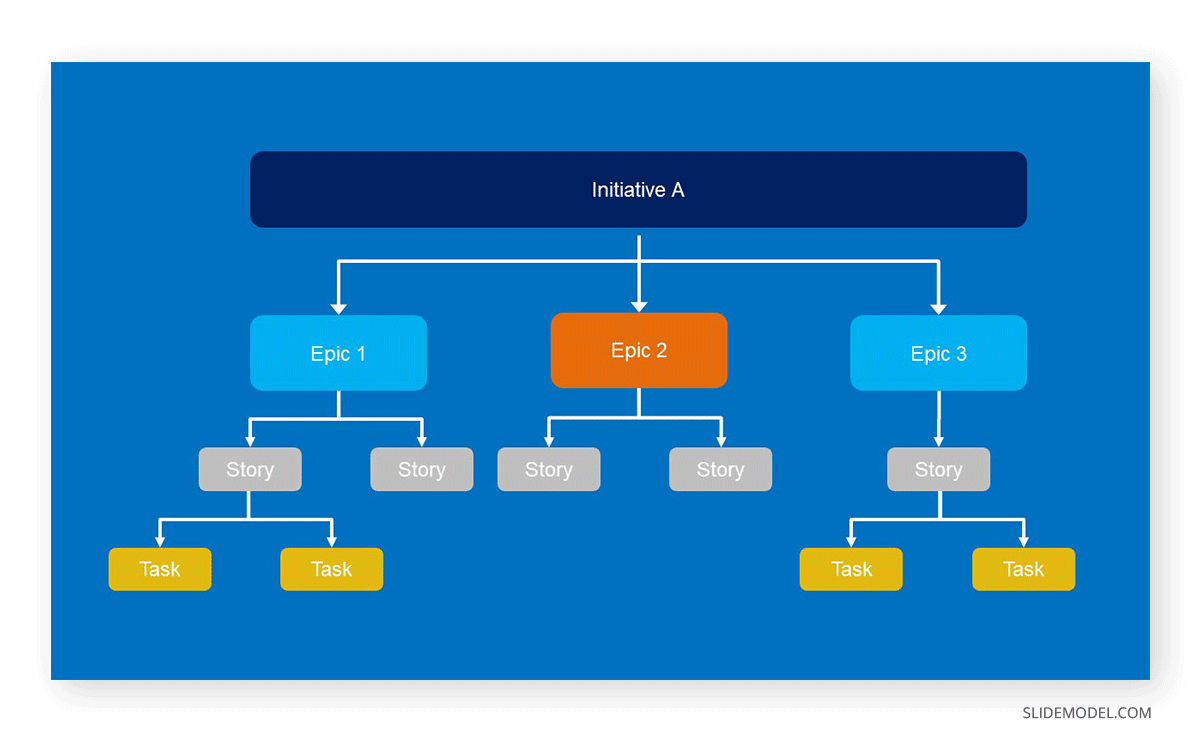
Features Roadmap
This is one of the most commonly used roadmaps and is typically used externally. They help to communicate when new features will be released, and to which area they are focused (i.e., Consumer, Scalability, Performance, etc.)
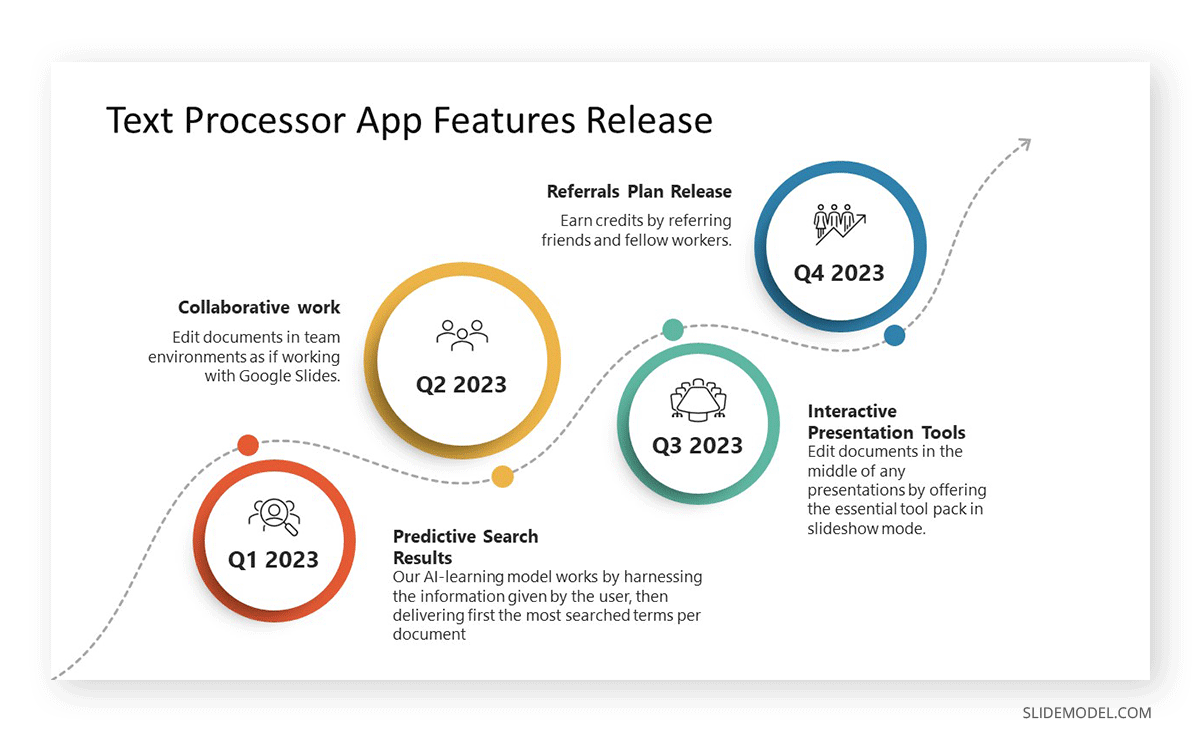
Portfolio Roadmap
Whenever we need to display multiple products on a single view, portfolio roadmaps make this task an easy feat. They are tools used mostly by the leadership level, as they allow us to take the full dimension of projects running in parallel and how are HR and technology efforts allocated for each section.
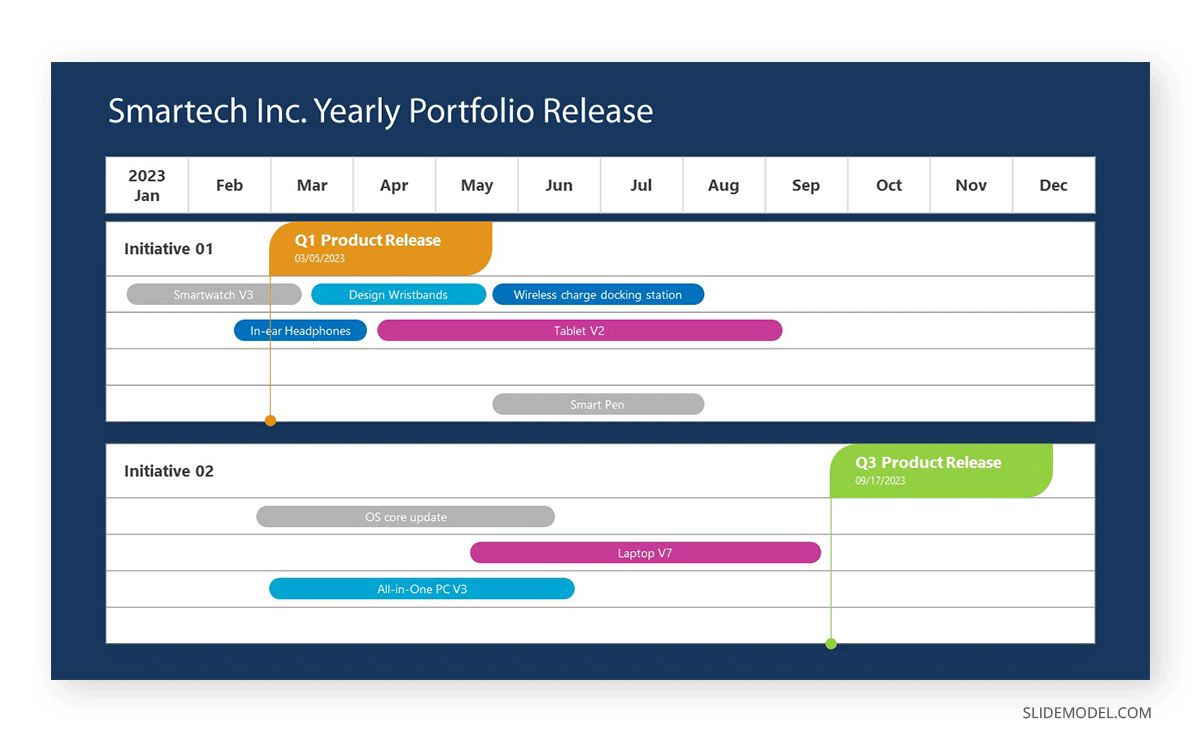
Release Roadmap
Marketing and sales teams are the main users of this type of product roadmap since it is a tool to communicate all the activities linked with the release of a product. It is an outline in a timeline format of the dependency tasks to fulfill before the release, who is in charge of each task, and how they correlate between departments.

One clear example is to coordinate training sessions involving sales representatives and customer support about a new feature to be introduced in a product. Both departments must be aware of the ins and outs of this new functionality to attend to the customer’s demands properly. Still, the training course must be completed before the estimated release date.
Strategy Roadmap
A strategy roadmap is a high-level document used by the leadership to outline the areas in which an organization’s focus must change and why those changes are required concerning the organization’s vision. It is the step prior to a Strategy Plan as it implies the sequence in which changes ought to happen; in contrast, the strategic plan focuses on how to accomplish each stage and by which timeframe they should be completed.
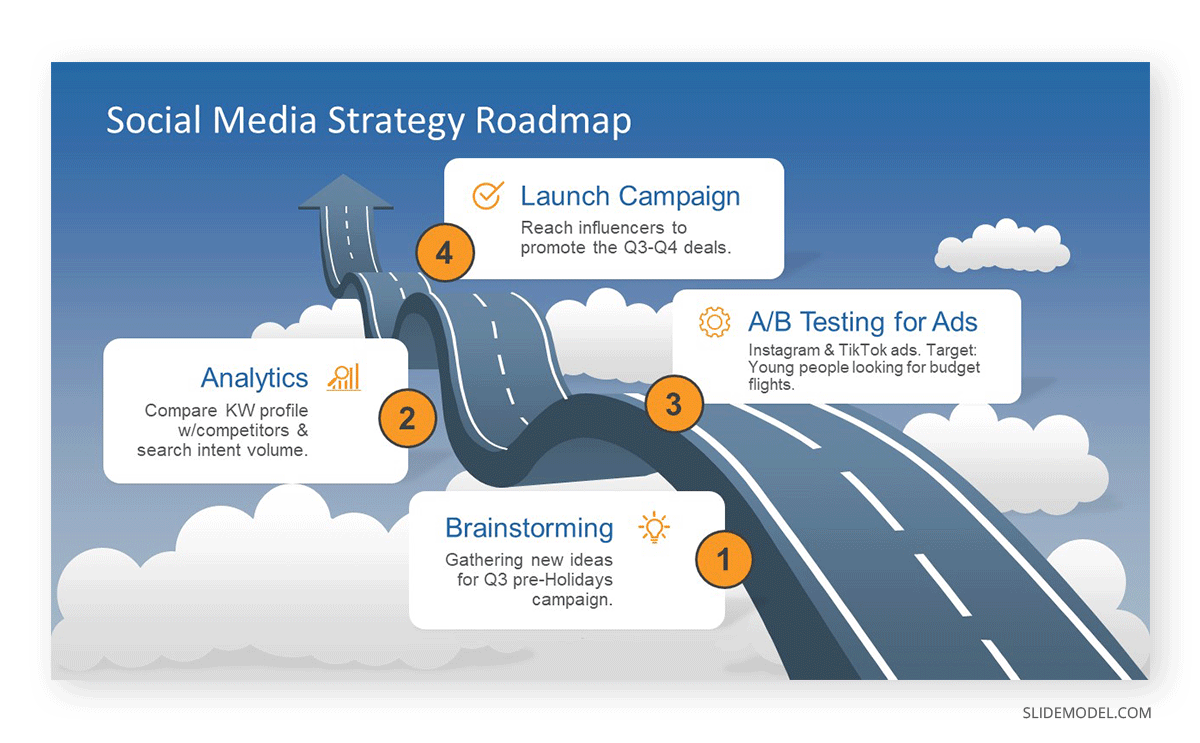
Theme Roadmap
The term themes in product management refer to high-level goals to be completed in a specific timeframe. In Agile terms, themes are made of Initiatives, Epics, and Stories, as they cover significant areas of interest in a company.
To clarify this point even further, let’s we will illustrate a typical Theme-based Roadmap example:
A technology giant wants to increase customer loyalty by improving their existing features according to customer feedback (Theme). They identify three pillars in which their efforts can take action: smartwatches, mobile phones, and tablets (Initiatives). The company proceeds to introduce an upgrade to its upcoming smartwatch model to enhance GPS tracking for outdoor swimming (Epic). To accomplish such a goal, they previously had to improve the time span of water resistance, water resistance depth, introduce weather forecasts and sync no-swim area warnings from information retrieved by the coast guards (Stories).

Technology Roadmap
Technology roadmaps are low-level documents that aim to organize and prioritize tasks for the production team. It is an internal document, and product managers can instantly address tasks that demand more human capital and monetary resources. It can be used in conjunction with the Capacity Roadmap for inter-department collaboration.
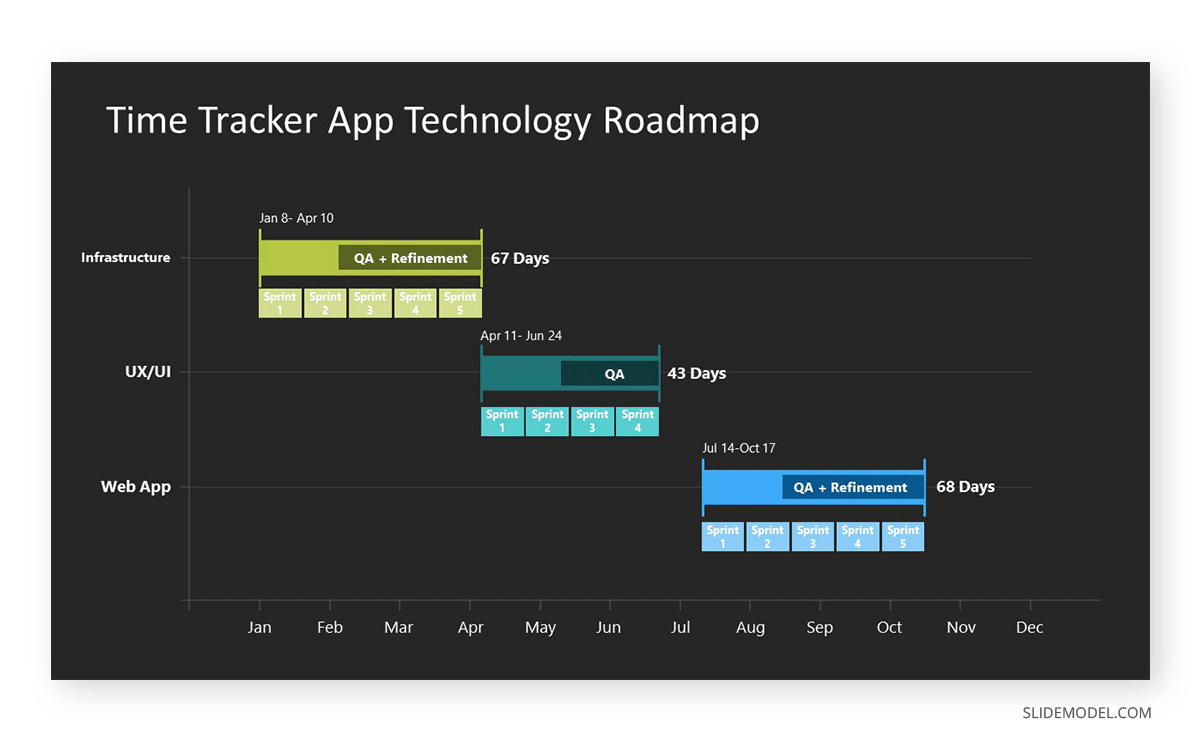
A software roadmap, a crucial component within the broader technology roadmap, specifically outlines the development lifecycle, key milestones, and updates for software projects. This distinction is vital for clarifying the roadmap’s scope, as it allows for the detailed planning and execution of software-related tasks while maintaining an overview of all technological advancements within the organization. Agile methodologies, commonly employed in both hardware and software development, highlight the roadmap’s flexibility and adaptability. An example of an agile-based technology roadmap, which might include a dedicated software roadmap section, can be visualized using our Agile Product Release PowerPoint Roadmap Template. This approach ensures a holistic view of technological progress while giving special attention to the nuances of software development.
Now-Next-Later Roadmap
This product management tool is ideal for prioritizing tasks, as we get the three-time dimensions each organization constantly moves in between: Now (present tasks), Next (upcoming, immediate tasks), and Later (planned tasks, either mid-term or long-term).
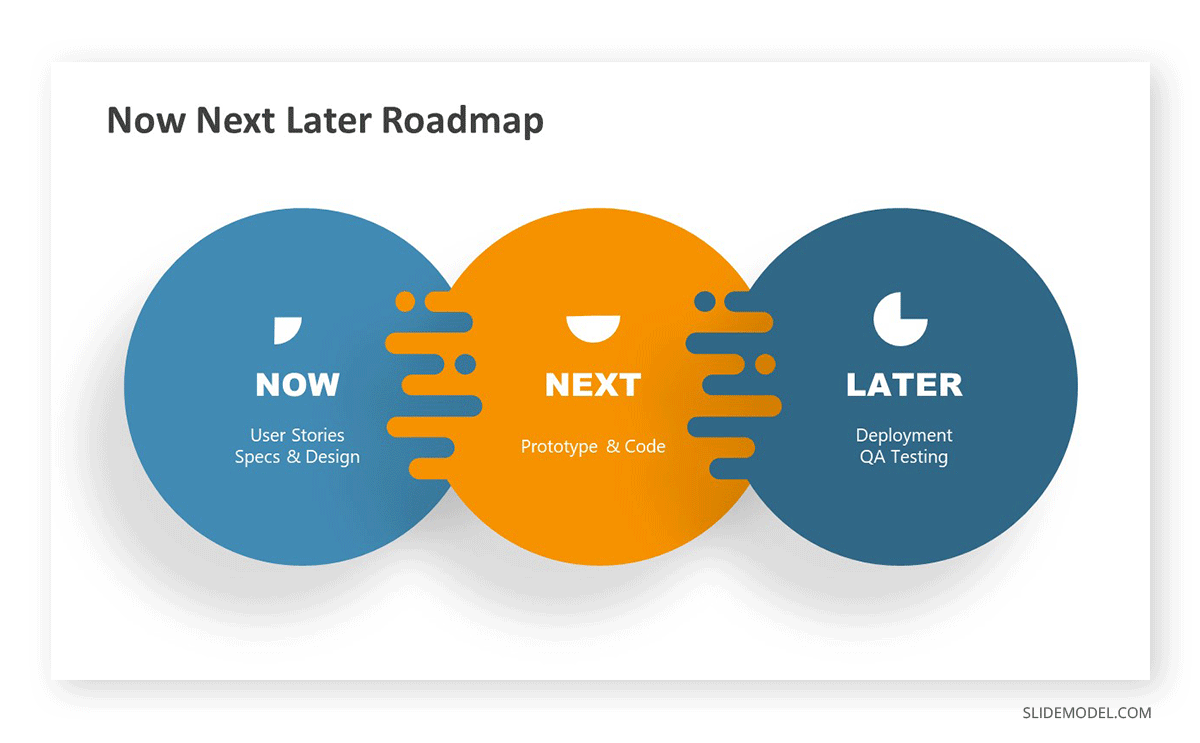
Tasks must be strictly linked to the product’s vision and serve a quantifiable business objective. Some software solutions like Jira offer native functions to create this kind of roadmap. If you prefer to count on a visually-appealing solution, you can check the Now Next Later slides for PowerPoint.
Opportunity Roadmap
Sales departments use an Opportunity Roadmap as a tool to align future initiatives with problems their potential customers currently experience. It serves as a backlog of ideas that help build feature roadmaps, giving enough time to test and experiment with results before defining them as features to be added to the product.
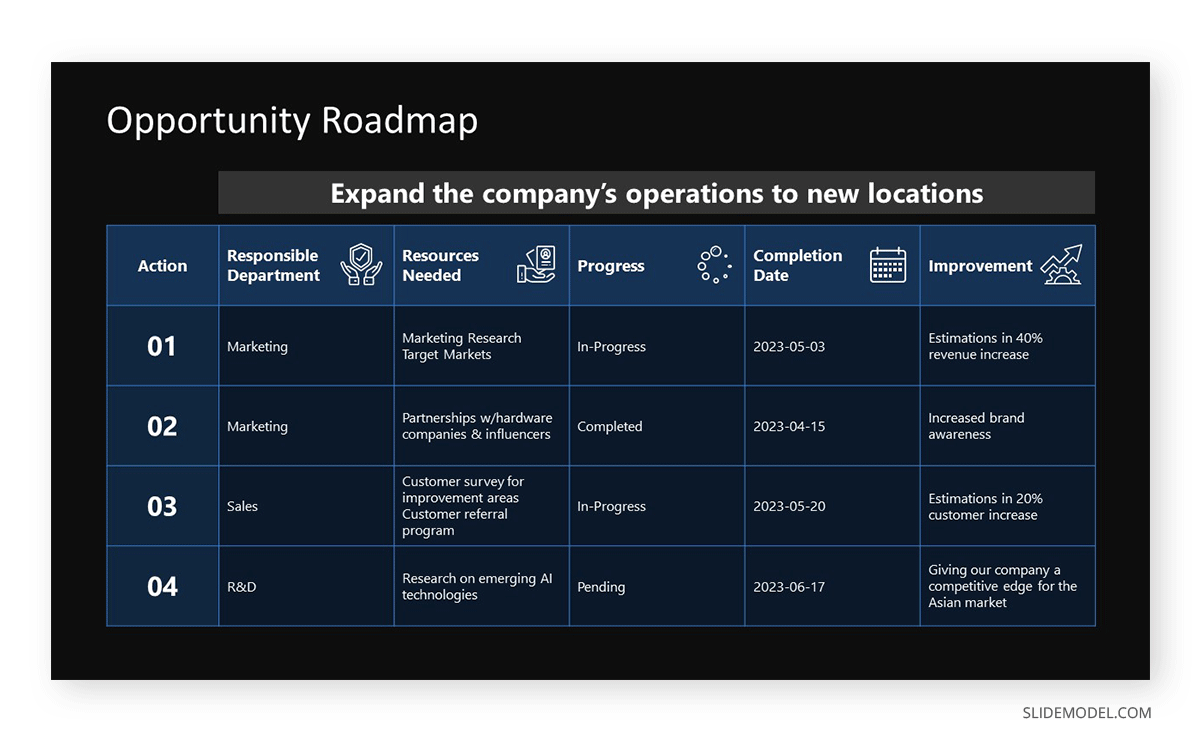
Customer feedback, market research, business goals, insights from I&D teams, etc., feed the information to build an opportunity roadmap.
Capacity Roadmap
It has multiple aspects similar to the release roadmap. Still, it helps departments to communicate by acknowledging when the right resources for each stage will be available and how much time they consume per task. They are critical for management and leadership to acknowledge if production resources are properly allocated per task and if budget adjustments ought to be made.
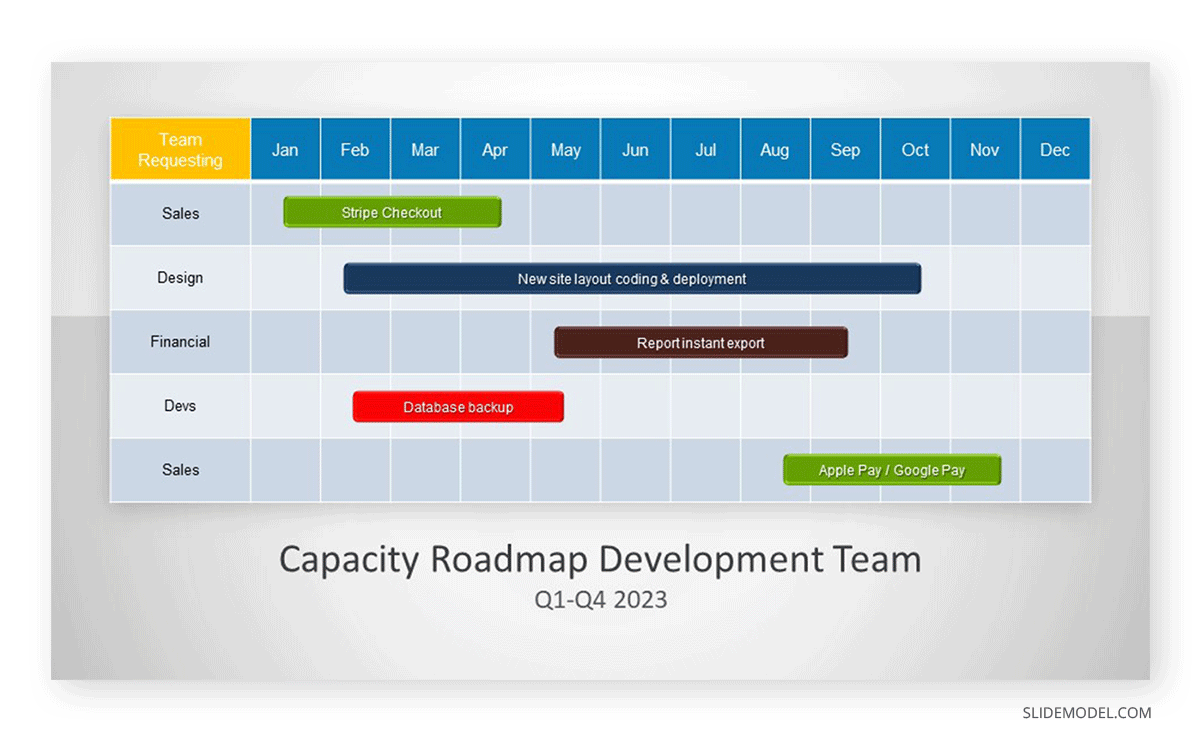
How to build a Product Roadmap
In this section, we will explain how to create a product roadmap. Let’s get started by analyzing which content to include in a product roadmap and then we present a 4-step process to create your product roadmap.
Which content to include in a Product Roadmap
The first step you have to take on how to build a product roadmap is to define its type, as content requirements are different from each other. A technology roadmap will list the number of technology-related tasks the development team must complete and by which timeframe, as well as indicate to which area they belong (infrastructure, UX/UI, mobile app, web, etc.)
It is critical to trim the information to only list the key points that make the document understandable at first glance. Overindulging in information results in dense documents that look intimidating to read or take an immense amount of time to update. Both outcomes are failures in product roadmap design.
4-Step process to build a Product Roadmap
Step 1 – Tailor the product strategy
Acknowledging the strategy goal and initiatives for the product development is the starting point of any product roadmap. Stakeholders must understand the “why” behind a product and align decisions to support that strategy course. This can also be reinforced if your product strategy gears around your potential/actual customers, their needs, and your market strategy. All those elements should be informed in your product roadmap.

Step 2 – Organizing ideas
As previously mentioned, the influx of ideas retrieved from customers’ insights plays a key role in a product’s success. Internal teams must approach ideas from a multi-disciplinary view and sort them according to how they shall serve the product regarding scalability, performance, brand growth, etc.
How do we then prioritize ideas? It is undoubtedly a problem, especially if two different departments (i.e., development and sales) have contrasting views about features or conflicts in terms of technology. Sort out this brainstorming process by scoring these ideas based on the KPIs that back up your product strategy. You can represent this process by using bar charts or percentages and culling them according to this criterion:
- Planned
- Pending Review
- Discarded
- Already Implemented
- Completed
- Future Iteration
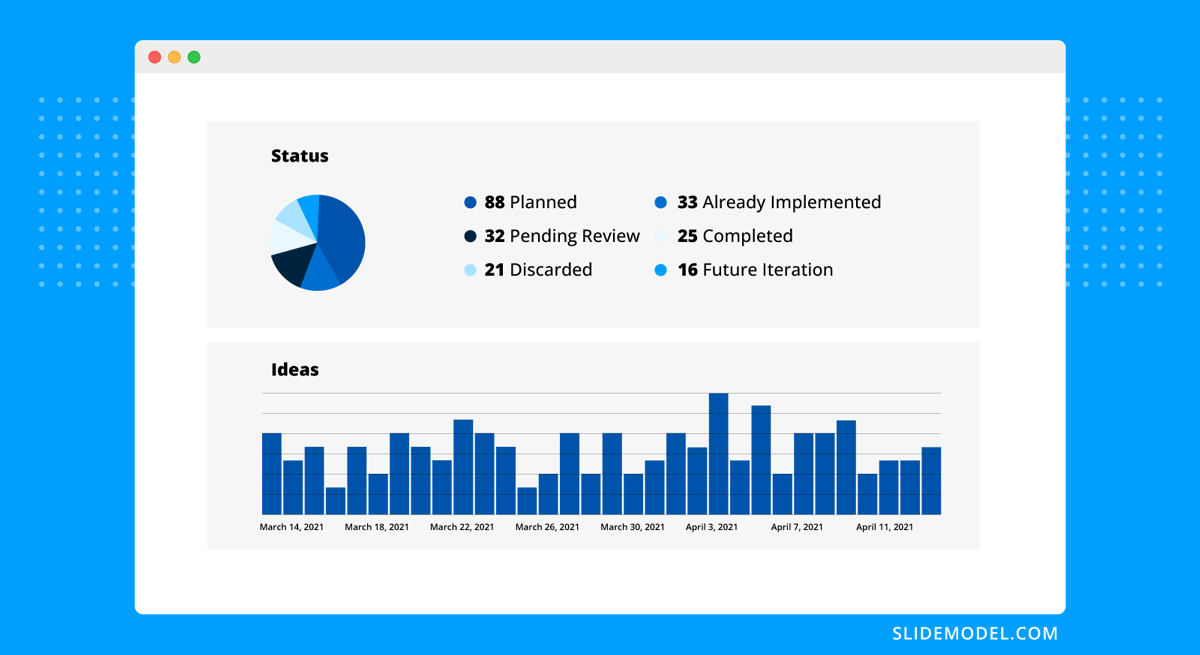
Step 3 – Listing Features and Requirements
Organizations can use a feature product roadmap to align their efforts and proceed to develop new features by their priority level. An ideal classification would be:
- Key Feature
- Design
- UX
- Security
- Marketplace
- Mobile
- Desktop
- Community
- Database
Then, we can cross-reference the features with the technology roadmap and the opportunities roadmap. This three-tier process helps teams pinpoint which features are critical for the product performance and which are merely design-based decisions that won’t result in losing customers or exposing sensitive data.
After the features are sorted by category and priority, product development teams must update their technology roadmap to meet the deadlines for introducing new features.

Step 4 – Work with releases
We don’t have to associate the term “release” with a fully-completed product. Much like what happens in software development, with beta versions being released for users to test new functionalities, your product can have a similar process that also drives flow into development.
These release dates must be realistic, with backup plans that don’t compromise the release of another feature (to avoid triggering a chain reaction that hinders the final release date). Be sure to cross-reference these release dates with the capacity roadmap, so you have an overview of when your resources can meet the estimated deadlines.
How to plan technical debt in a Product Roadmap
Addressing the impact of technical debt is one of the critical responsibilities of the product manager. This accumulation of work is natural in product development. Still, it is not a direct consequence of taking shortcuts – sometimes deadlines must be met, and product developers must secure functionality with short-term solutions.
Our recommendation is to work with a factor of safety for milestones, which implies giving an extra margin of time that can help fix the low-effort technical debt. At the same time, you can list a technical debt swim lane in your product roadmaps, identifying the individual technical debts by area or relating them with an internal code that references the features roadmap.
This technical debt roadmap must be placed inside the technological roadmap, which is relevant to the product developers. Ideally, teams should review technical debt after sprints to avoid delaying tasks when the project reaches its final stages. Such practice helps teams to address the importance of efficiency in workflows.
How to prioritize items in a Product Roadmap
Defining which tasks should take priority or become part of a critical path is challenging if we’re not in touch with the product’s vision. For this reason, we invite you to follow these suggestions to speed up the process and know when a task should be prioritized over others.
User’s insights
Working with user feedback is a way in which product managers can locate what’s strictly required to improve for a better UX performance. For example, if an application crashes when the user tries to access a specific function, that situation doesn’t appear in the testing environment. It is a top priority for the development team to go over that problem.
Users can also suggest features they would like to see in future updates. Still, we can learn much about consumer behavior by implementing tools like website heatmaps.
Respecting the critical path
There is a compendium of co-dependent functions to ensure our product’s functionality. That’s known as the Critical Path, and we can speak in terms of a general critical path or a function-dependent critical path (meaning the items required to make a feature work). If improving or troubleshooting some of those features is a pending task, be sure to prioritize this kind of work over adding new functions.
Value vs. Complexity
We don’t have to assume that all critical tasks bear the same complexity level. In the same line of thought, not all complex tasks bring product value, but in some cases, complex tasks are required to ensure the functionality of our product.
To preserve a non-biased approach to this dilemma, we can create a 2×2 matrix in which we can organize pending tasks according to this criterion:
- Tasks that bring value and have low complexity.
- Tasks that bring value and have high complexity.
- Tasks that do not bring value and have low complexity.
- Tasks that do not bring value and have high complexity.
Start with the tasks that bring value and have low complexity, followed by the ones that meet the no-value/low complexity criteria. Why? Because it is a good way to keep technical debt at bay. If a task that brings value and has high complexity is also part of the critical path, then that said task should be the top priority. For the tasks that don’t bring value and have high complexity, organize them according to the closest value reference they may bring; otherwise, ditch them altogether or opt for value-worth alternatives.
Scoring model
This approach works similarly to the 2nd step on how to build a roadmap. Your team should implement a scoring model by which stakeholders assign a score to each task by category, cross-referenced with their expected business value. Variables such as complexity, implementation costs, risks, and operational costs must be considered; then, you can rank tasks by that scoring model.
The main advantage of using a system like this is that you give voice to your team members rather than blindly assigning tasks without considering their insights.
Gathering ideas from an Opportunity Roadmap
After all vital tasks were prioritized, it is worth checking what our Opportunity Roadmap may bring in terms of innovation. Remember, this tool is crafted after I&D research and market research, among other actors.
Quality ideas may be neglected as other tasks take higher priority in the task queue. Give your team 10 extra minutes to discuss potential ideas to extract from the opportunity roadmap, then classify the approved ideas using another of the methods discussed in this guide.
How to define metrics of success in a Product Roadmap
We can name countless KPIs or OKRs for product management, but the reality is you need to ask yourself these questions to define which metrics of success your project requires.
Which metrics are compatible with my product
E-Commerce products have their own set of metrics, such as impressions, CTR, bounce rate, etc. These metrics are by no means applicable to the manufacturing industry, where OEE, throughput rate, capacity utilization, and many others are the values we ought to track for an efficient product development process.
Which are the stakeholders for the metrics I track
Depending on the audience of the product roadmap, you need to tailor the metrics to present to show improvement from the last iteration or signal potential production problems. For the leadership level, production costs, time spent per product, market value, etc., can be metrics that guide decisions or impact release dates. On the other hand, the development team will focus on metrics relevant to the technical area, as it is the method by which they benchmark the team’s performance.
How to add multiple products to a single Product Roadmap file
Listing multiple products on a single product roadmap is commonly done by the leadership level. It gives us an instant overview of parallel production, particularly emphasizing teams’ performance. It is, however, a challenge on its own due to these potential hazards:
- If you work with multiple products, the detail to showcase per product is limited. You cannot compact information and expect the same level of understanding as with individual product roadmaps.
- Updating is a complex task for product managers, and it can lead to delays or overlapping content.
- If you present multiple products, the leadership can have different views on your prioritization system, inducing delays on individual projects to speed up other flagship products for the company.
To create a quality multi-item product roadmap, please follow these steps.
Step 1 – Define the goals for the roadmap
Place yourself in the shoes of the audience. Which items will pique their interest? What is it that they intend to learn from the roadmap? Then, look to align the goals of each product to the overall objective to present: innovation results, performance improvement, technical problems, etc.
Bear in mind the organization’s vision and work your way to make each product highlight how they fit into it. You can also hire a product management consulting firm that can help you plan and create a multi-product roadmap.
Step 2 – Select the products to list in the roadmap
The placement of each product in the roadmap document is not a random sorting. They should be listed according to their priority level in alignment with the company’s goals. If two products share the same priority tier, put first the one with a more completion rate or a shorter timespan for its development, then list down the second option.
Step 3 – Designing the product roadmap
Work your way to present the document by using a product roadmap template. As a tool, it simplifies the design-related options and gives you a framework by which each product has the same number of goals and key initiatives to showcase.
It is vital to offer a clear picture of each product’s goals, which are the metrics of success used to determine evolution over time, and the value they deliver to the organization.
We advise restricting the color palette to no more than 3 contrasting colors, as otherwise, it would distract the interest from the content to design decisions. As a plus, include the resources deployed per project and which are strictly required for each project to continue advancing. It is a good practice to prevent resource reassignment when you expect it the least.
Step 4 – Create cross-references between the general product roadmap and each product roadmap
In some cases, the leadership may lose focus on vital aspects of a product, hence requesting a more “detailed” view. If you were cautious enough, by assigning a code system to each product, you could present the documentation linked to each product professionally. This can mean the individual product roadmap for that project, reports, analyses, etc.
Design suggestions for Product Roadmaps
The first design element you must take into consideration is that product roadmaps can be represented in two formats: timeline or swimlane (similar to a Gantt chart), which are used for time-bound tasks, and cards (their implementation resembles a deck aligned on a board – they are not time dependant).
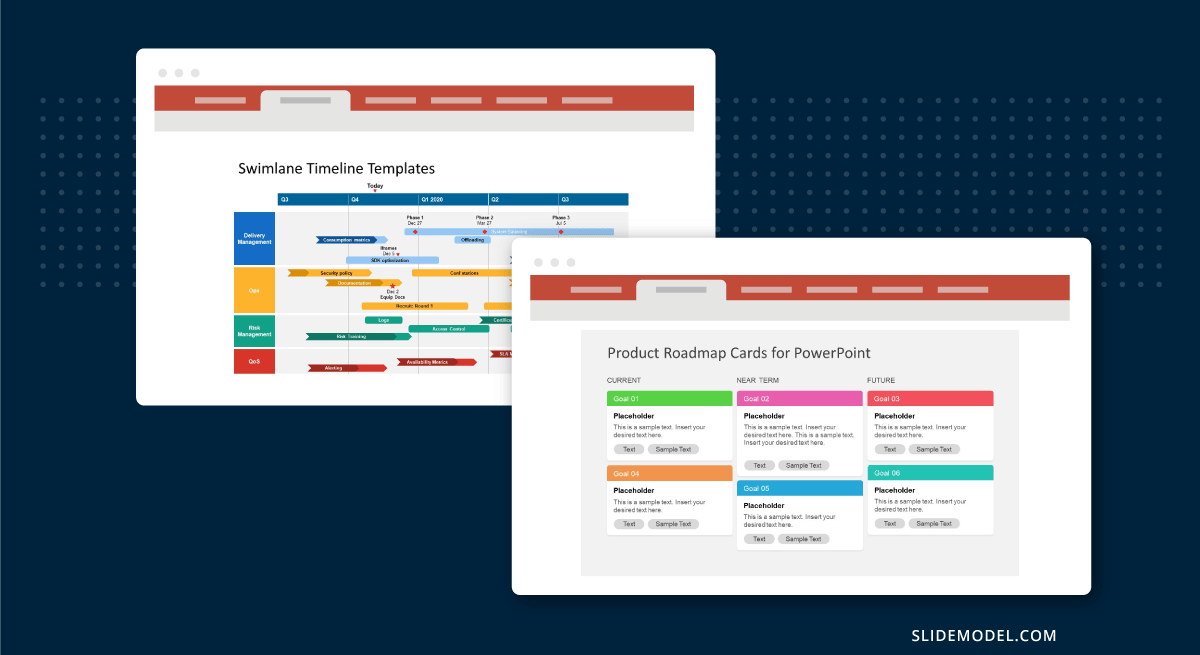
Work with color as a friend to easily identify tags, categories, statuses, or priorities. Don’t focus on creating beautiful color schemes – sometimes clearly contrasting colors are what the roadmap needs to visualize the information quickly.
For timeline diagrams, implementing a bar fill helps to instantly visualize an epic or story’s completion percentage. Depending on the software you use, updating these bars can be a nightmare for complex projects, so we recommend using this design technique on low-scale projects that will be updated constantly. From a psychological side, it is a gamification tactic that helps workers feel inspired to keep completing tasks as the bar gets filled.
It is important to understand dependencies on product roadmaps, and much like flowcharts, lines, and arrows are visual aids that help us understand the relationship between tasks. You can use a color scheme to differentiate between critical and common dependencies. As a practice, that helps to prioritize upcoming tasks. Remember to highlight the critical path with a unique color or line weight, especially if the document is shared across departments.
Tools to build a Product Roadmap
Jira
Jira is the option preferred by Agile projects. It provides an easy-to-use user interface with powerful tools such as Kanban boards, reporting templates, DevOps tools, dependency & capacity tracking, etc.
Timelines are entirely customizable to the user’s preference, not altering the document for all members in the organization, which helps users to feel more comfortable with the method used to understand the information. Another fantastic feature is that we can create tasks from the roadmap view, so there’s transparency across all levels of the organization and accountability. All users can see who is in charge of the task and when it’s expected to be delivered.
We can find integrations for the Adobe suite, Google Workspace, Microsoft 365 & legacy versions, Slack, Zendesk, Zoom, Dropbox, etc.
Microsoft Excel
As part of the Microsoft Office (now Microsoft 365) suite, MS Excel offers plenty of tools to create any product roadmap from scratch. The problem lies in one variable: Excel’s lack of a user-friendly approach when managing formulas.
If your document is to be managed by several users, be cautious about restricting functions that only the product manager should alter and preserve a backup copy to prevent disaster. Documents linked by reference from other documents are susceptible to experiencing bugs because one person mismanaged a data input, creating a trail of errors across all related documents.
Unlike what happens with PowerPoint, design-based choices in Excel are restricted, so if graphics are a priority for your team, opt for PowerPoint.
Microsoft PowerPoint
If you intend to work with professional product roadmap templates, PowerPoint is the option. Saving time with design decisions is a life-changer. You can tailor the document to your branding style, import tables from Excel, and do many other productivity tasks due to its integration with the Office ecosystem, add-ins, and third-party tools.
We recommend you check our detailed guide on creating a roadmap in PowerPoint and our selection of roadmap PPT templates.
Microsoft Project
Regarding roadmaps, Microsoft Project is the tool for the task. Although ideally, you can work your way only with MS Project, the usual method business professionals use is a collaboration between Project and PowerPoint: you create the required assets in Project, using all the tools offered to design a product roadmap. You export Microsoft Project files into PowerPoint to give the design aesthetic to your presentation or report.
An important feature to highlight is that you can alter the information inside PowerPoint itself or in the original Project file, then update the imported data in PowerPoint.
Google Slides
Google Slides is the free alternative to creating a product roadmap in PowerPoint. You can work with product roadmap templates for Google Slides – which offer almost the same functionality as PowerPoint ones – or start from scratch. Regarding integrations, you can import data from other Google Slides documents, Google Sheets, or third-party extensions.
All the information is preserved in a cloud-based format, meaning multiple users can access and edit the document in real-time.
Zoho Sprints
Zoho Sprints is preferred when working in Scrum teams as it provides easy in-depth collaboration between parties. You can work with native roadmapping tools, task scheduling & tracking, among other project management tools. The UI is friendly to approach, with a drag-and-drop system that helps team members visualize each task.
You can work with the integrations provided for Microsoft 365, Google Drive, Zapier, Zendesk, and more.
Interactions with Microsoft Planner
Microsoft Planner is a web-based application offered by Microsoft in their Microsoft 365 subscription plan. This project planning application is also compatible with Android and iOS, but its versatile use allows business professionals to speed up processes. You can run your product management meeting in Microsoft Teams, bring up tasks from Microsoft Planner, or even create them ireal-timeme. Such tasks are then available for all members across the organization.
This Kanban solution allows you to export data directly into applications like MS Excel or PowerBI. You can visualize your team’s progress on each task or initiative; therefore, it is an ideal application to align your team’s effort without requiring extra expensive software solutions.
How to present a Product Roadmap
After defining your goals, selecting your tools, and designing your product roadmap presentation, it is time to deliver it to an audience. Here are some insights from our expertise on how to make a successful product roadmap presentation. We also invite you to check this video that summarizes the process of creating a roadmap presentation.
Consider the context
You need to be mindful of where you are presenting your roadmap and the stakeholders involved in the meeting. Your approach has to be crystal-clear about your expectations from the meeting, the precision with which you showcase the information, and how to command instructions from your team at the end of the meeting.

Technical groups expect proof-based results from what you consider progress or a delay and why they should work on a new feature instead of prioritizing another. In turn, the marketing team doesn’t want to know the technical reasons why a feature cannot be implemented if they need it as a key strategic element in their sales propaganda. They will understand monetary/capacity-related reasons but lose themselves in lengthy technical jargon.
Consider the commitments you made
This is related to keeping your product roadmap as realistic as possible. The document is shared across different levels of your organization, with them using the information to fit the needs of their working area. For example, you cannot list a feature you know is impossible to deliver on the expected date or, worse, impossible to build. Why? Because different departments may be reaching out to potential buyers or investors promoting such features, to find out later it was a ruse.
Keep a backlog of the interactions you made with all stakeholders involved. Then, check the changes made in the process and see how they align with your prior commitments. If you face breaking a previously-accorded commitment, gather fact-based information to expose the case as clearly as possible, offering actionable alternatives as compensation. In this regard, keeping product roadmap documents updated is vital to prevent last-minute surprises during product roadmap presentations.
Acknowledge the interests of different stakeholders
Product roadmap presentations are not an event that happens in one instance only; they are ongoing meetings in which you have to discuss the advancement of your project. But what if said progress may be controversial for some parts?
Planning stakeholder interviews at the initial stages of the product roadmap creation serves to comprehend those interests and build trust. It can bring insights into which modifications to the project may suit a group of stakeholders and how to prepare your arguments to defend the project when positions don’t align.
Stick to a presentation agenda
Product roadmap presentations can turn into nightmare-length events if you don’t lay out the objectives of the meeting on the first slide. You need to consider the required time to introduce the milestones completed before the meeting, your observations regarding the process flow, what could be improved, and your expectations for the upcoming meeting, plus give extra time for a Q&A session.
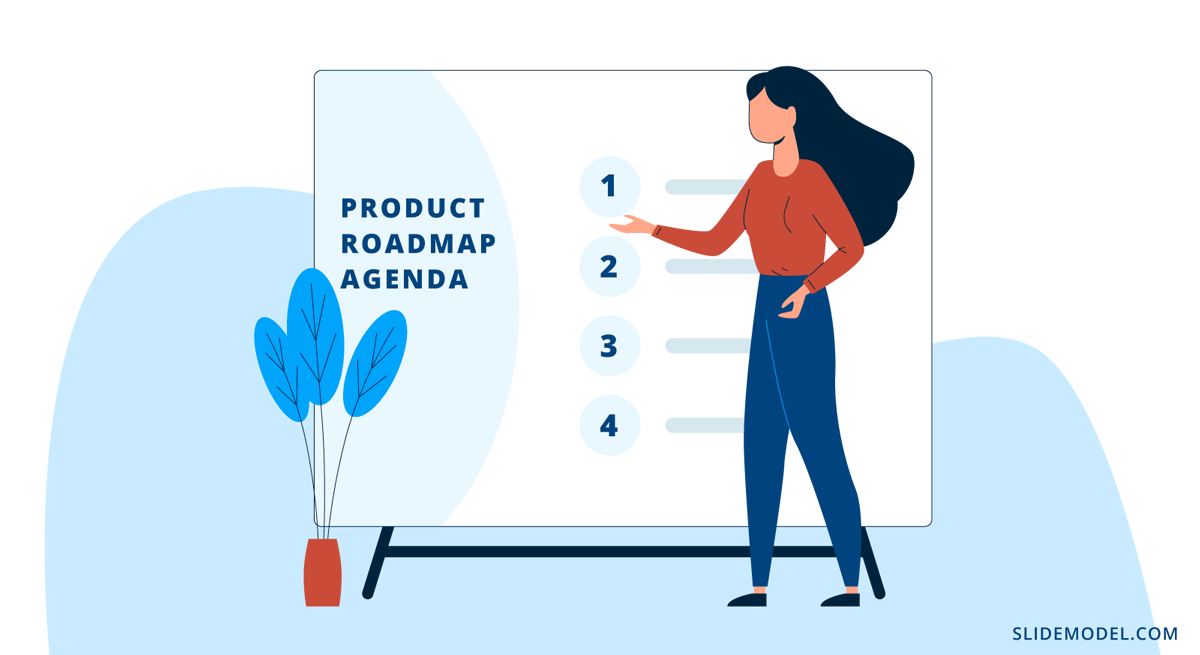
Depending on the audience for your presentation, you can repurpose the agenda slide for presentations with different teams. During the Q&A session, practice active listening, and note down or record (if allowed) the comments made by stakeholders. That information can be used as a reference for new action courses.
Deliver a distributable
It is a good practice to allow stakeholders to analyze the contents of the product roadmap some minutes prior to the meeting, so they focus on what you have to mention rather than analyzing graphs and charts while you speak. You can work with these formats to distribute the document:
- Physical (printed format)
- Cloud-based (Notion, Google Slides)
- Internal platform access
Updating a Product Roadmap
Just as important as defining priorities and building a roadmap, updating that product roadmap is one of the core responsibilities of product managers.
The product roadmap update ratio depends on how often meetings are hosted. Once a month is a good practice, but complex, large-scale projects can work with bi-monthly or quarterly revisions.
What should you include in a Product Roadmap update
There are 4 critical points to address in a product roadmap update:
- Customer/Team Feedback: Grab insights from internal and external resources to your project for an accurate picture of where the project stands. This information should feed the technology and features roadmap with changes to be made.
- Technical Debt: Don’t wait until the last minute to address technical debt. During your product roadmap revision, give enough time to each department to report their technical debt, then devise a plan for how you can reduce it during the next sprint.
- Progress: It is time to see the full picture, so compare your progress metrics to the success metrics you initially established. Discuss with your team the highlights and how to fix whatever issue affected optimal performance or progress rate.
- Changes backlog: Since you are updating the roadmap, it would be wise to keep a backlog of all the important decisions that led to the roadmap update and the reasons behind them. Although a bit tedious, this practice can save an insane amount of hours when contrasting opinions put work to a halt. And yes, going back 2 or 3 updates to check why you made a certain decision is a scenario that happens far too often.
Reasons why your Product Roadmap may fail
#1 – Limiting autonomy at the team level
When the product roadmap deadlines are too restrictive, teams feel they are losing their autonomy and usual workflow to serve the needs of other departments. This harms the company’s culture, the innovation potential and builds resentment between coworkers as some teams may feel others have more time to perform the required tasks.
The best approach to prevent this problem is to have an open mind about updating the product roadmap due to suggestions from different teams and having useful feedback after each sprint is completed. Agile methodologies focus on constant improvement, not a fixed mindset, which your team should embrace as a core value.
#2 – Losing perspective of your customers
How often do we delay deadlines because we feel the current project stage is not “perfect” or that another iteration may solve extra, unsolicited problems? Product developers often fall prey to focusing too much on individual features rather than seeing the full picture. Perhaps your customer doesn’t care if your application’s loading time is reduced by 2.4 seconds, but they shall certainly care if they cannot go through the checkout stage.
First, base your working methodology on fulfilling epics, not picking random stories because “they look important.” Keep an eye on the hierarchy of processes, then opt between tasks of the same level by priority. Measure your progress by contrasting the performance of this new iteration with the feedback received by your customers. Fix crucial items that don’t allow a quality user experience, then move on to the accessory items.
#3 – Working with a faulty tech stack/team
If your product management workflow still depends on pen & paper, it’s time to address whether your organization’s processes are outdated. Archaic work methodologies consume vital time for the product development cycle and demand a higher budget. Instead, put the investment into automating tasks and how to enhance existing processes.
Acquiring new tools for crafting a product roadmap is only one step on the ladder. Your personnel has to master a variety of functions in those tools to perform their daily tasks. They need to work on communication techniques that drive value, not attend meetings to fulfill a task. Using the “constant improvement” mindset, set time aside for your team to attend continuing education programs, which can be hosted in-company, so the content aligns with your organization’s needs.
#4 – Messy or difficult-to-understand information
Suppose the product roadmap goes in the “too detailed” direction; the information may seem misleading since the strategy is cluttered with unnecessary pieces of information for the target audience they have. For example, providing a technology roadmap to the sales team, filled with technical jargon, when they need a clear external product roadmap to show potential customers.
Focus on two core items: the strategy and the target audience for the roadmap view.
Best PowerPoint Templates for Product Roadmaps
In this section, we will list what we consider the best PPT templates to use in product roadmap presentations.
Closing Thoughts
Product roadmaps are vital for product development teams to track progress and align the organization’s vision across short-term and long-term goals on each project. Their usage is the first step in crafting a product strategy as they help transparently convey information, outlining the vision, direction, and priorities for a specific period.
This product management tool isn’t restricted to the usage of new products; as we have seen, it is an essential tool for outlining product upgrades or revisions. Their value in agile practices is widely known, so we must acknowledge their potential for daily work and strive for excellence in multi-disciplinary team collaborations. For more information, check our article about product management best practices.


